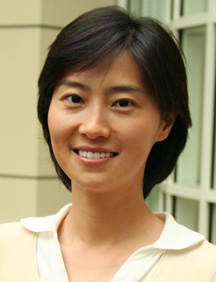

Analysis of Protein-Building Enzyme Sheds Light on Protein Evolution
By Laura Bonetta
Like switching tools on a Swiss army knife, some proteins in the body can perform different activities depending on what's needed.
Having more than one function on a single protein is an efficient way to expand an organism's arsenal of tools and capabilities. But it also presents a design challenge. How do you arrange the activities so that they don't interfere with one another?
Associate Professor Xiang-Lei Yang of The Scripps Research Institute sought to find the answer by examining an enzyme—a type of protein that carries out chemical reactions—involved in assembling proteins.
This critical enzyme also functions as a cytokine, a type of messenger that relays signals between cells. In a study published in Chemistry & Biology on May 29, 2009, Yang demonstrates that these two very different functions are kept separate on the protein, preventing any interference. "But we found there is also cross talk," explains Yang.
The findings have implications for understanding how proteins evolve. In addition, because cytokines are known to play important roles in inflammation—one of the ways in which the body protects itself from foreign substances—the study may provide insights for the development of novel therapies.
Protein Building 101
All proteins consist of amino acids linked to one another into chains that are then twisted into three-dimensional shapes. These amino acid chains are assembled by ribosomes—the protein factories of cells—using instructions encoded in the cells' genetic material, DNA.
The job of bringing amino acids to ribosomes, so that they can be added to the appropriate spot in a growing chain, belongs to transfer RNA (tRNA). A particular tRNA molecule is linked to one of 20 amino acids in a chemical reaction called aminoacylation—a step accomplished by a family of enzymes called aminoacyl-tRNA synthetases.
One such enzyme, tyrosyl-tRNA synthetase (or TyrRS for short) is in charge of adding the amino acid tyrosine. But this enzyme also picked up additional functions during its long evolution.
Playing Two Roles
In 1999, Scripps Research scientist Paul Schimmel reported in the journal Science that when his team lopped off one end of the human TyrRS enzyme, the remaining portion was still able to carry out aminoacylation. But this truncated enzyme, which he called mini-TyrRS, had the additional ability of attracting immune cells and of stimulating the growth of blood vessels, two functions normally carried out by cytokines.
The full-length human TyrRS did not exhibit these new activities, possibly because in the longer molecule the cytokine function was hidden in the folds of the protein. In addition, the TyrRS enzyme found in lower life forms, such as bacteria, never showed any cytokine activity, indicating that this activity was added later in evolution. "It only became present in organisms as they started to evolve a primitive circulation system," says Yang.
Intrigued by the findings, Yang, who came to Scripps Research shortly after the publication of the Science paper, determined the atomic structure of mini-TyrRS. This structure, first published in 2002, gave the scientists a glimpse of how different portions of the protein were organized.
Based on this information and that obtained in subsequent studies, Yang was able to pick out seemingly important amino acids, change each one to a different amino acid, and then assess the effects of such changes, or mutations, on the protein's activities. The results revealed that most mutations affecting aminoacylation have no effect on cytokine activity, and vice versa. They also showed that amino acids critical to each activity reside in distinct regions of the TyrRS structure.
A New Type of Cytokine
Yang turned her attention to a three-amino-acid sequence, consisting of glutamic acid (Glu for short), leucine (Leu) and arginine (Arg), found in human TyrRS. The same Glu-Leu-Arg sequence is also found in several human cytokines that play key roles in inflammation.
The structure of mini-TyrRS revealed that Glu and Leu are located on the surface of the protein, whereas Arg is tucked inside. Yang found that when Glu and Leu were mutated, the cytokine function of mini-TyrRS was lost without affecting aminoacylation. On the other hand, mutation of Arg affected both functions.
"We could see from the crystal structure that arginine was located in a region of the protein that sits between the Glu-Leu-Arg motif and the active site for aminoacylation," says Yang. "Arginine's role may be to provide a link between the two activities." Linking cytokine activity to aminoacylation—a function critical to life—would help ensure that once the new activity was added to the protein, it would not be easily shed through subsequent rounds of evolutionary selection.
In addition to revealing important insights into protein evolution, this study of human TyrRS could have practical implications. The discovery that the Glu-Leu-Arg motif of TyrRS is critical to cytokine function indicates that TyrRS acts though a mechanism that links to other known cytokines. Cytokines are used as therapeutic agents in treating cancer patients and people suffering from various immune disorders or undergoing organ transplantation. Thus, human TyrRS represents "a very attractive therapeutic molecule," says Yang. "It represents a new class of cytokines that has been largely unexplored."
The first author of the paper "Mutational Separation of Aminoacylation and Cytokine Activities of Human Tyrosyl-tRNA Synthetase" is Mili Kapoor. Additional authors include Francella J. Otero, Bonnie M. Slike, and Karla L. Ewalt of Scripps Research. For more information, see
http://www.cell.com/chemistry-biology/abstract/S1074-5521(09)00085-4
Funding for this research was provided by the NIH and the Skaggs Institute for Chemical Biology.
Send comments to: mikaono[at]scripps.edu

A new study led Associate Professor Xiang-Lei Yang provides insights into proteins with more than one function. Photo by Kevin Fung.
